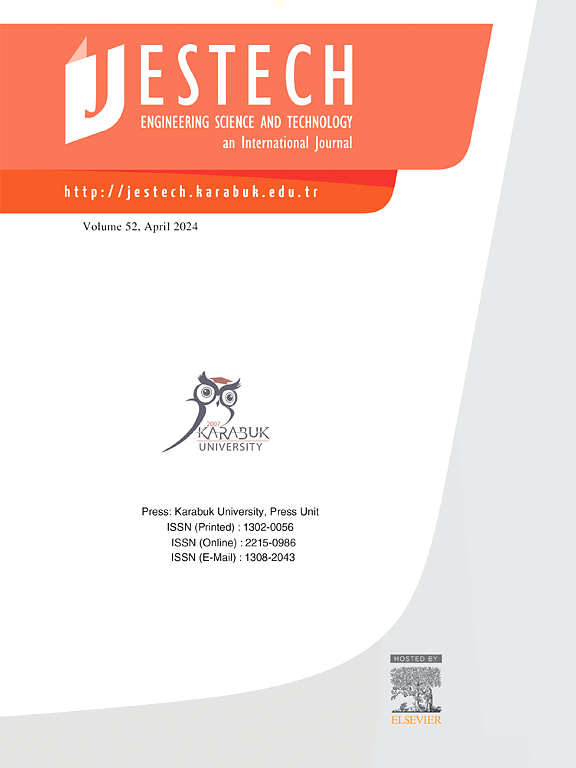Design and control of a novel 3-DOF parallel MFC micromanipulation platform
IF 5.1
2区 工程技术
Q1 ENGINEERING, MULTIDISCIPLINARY
Engineering Science and Technology-An International Journal-Jestech
Pub Date : 2025-01-01
DOI:10.1016/j.jestch.2024.101943
引用次数: 0
Abstract
In this paper, a three-degree-of-freedom (3-DOF) parallel decoupled micromanipulation platform (PDMP) driven by macro fiber composite (MFC) is designed, and a model recovery anti-saturation (MRAS) control strategy is proposed. Unlike conventional PDMPs, it exhibits a compact design with drive-mechanism integration and 3-DOF parallel decoupling with high natural frequencies. Also, the vibration suppression is transformed into a rate saturation problem, which avoids the micro/nano vibration of the carried flexible structure at the source. An electromechanical coupling dynamics model was established, and an MRAS control strategy combining the robust H∞ control and magnitude/rate anti-saturation control was proposed. The prototype was finally built, and various experiments were performed. The natural frequency is 627.66 Hz; the x ,y, and z motion strokes are 191.2 µm × 192.5 µm × 228.8 µm, with a maximum coupling ratio of 0.599 % and a displacement resolution of 9.86 nm × 10.11 nm × 9.85 nm. In addition, even when the amplitude and rate are limited, the MRAS control strategy can compensate for nonlinear hysteresis, suppress microscopic vibration, shorten settling time, and guarantee high accuracy. Experiments validate the effectiveness of the designed 3-DOF platform and proposed MRAS control strategy.
求助全文
约1分钟内获得全文
求助全文
来源期刊

Engineering Science and Technology-An International Journal-Jestech
Materials Science-Electronic, Optical and Magnetic Materials
CiteScore
11.20
自引率
3.50%
发文量
153
审稿时长
22 days
期刊介绍:
Engineering Science and Technology, an International Journal (JESTECH) (formerly Technology), a peer-reviewed quarterly engineering journal, publishes both theoretical and experimental high quality papers of permanent interest, not previously published in journals, in the field of engineering and applied science which aims to promote the theory and practice of technology and engineering. In addition to peer-reviewed original research papers, the Editorial Board welcomes original research reports, state-of-the-art reviews and communications in the broadly defined field of engineering science and technology.
The scope of JESTECH includes a wide spectrum of subjects including:
-Electrical/Electronics and Computer Engineering (Biomedical Engineering and Instrumentation; Coding, Cryptography, and Information Protection; Communications, Networks, Mobile Computing and Distributed Systems; Compilers and Operating Systems; Computer Architecture, Parallel Processing, and Dependability; Computer Vision and Robotics; Control Theory; Electromagnetic Waves, Microwave Techniques and Antennas; Embedded Systems; Integrated Circuits, VLSI Design, Testing, and CAD; Microelectromechanical Systems; Microelectronics, and Electronic Devices and Circuits; Power, Energy and Energy Conversion Systems; Signal, Image, and Speech Processing)
-Mechanical and Civil Engineering (Automotive Technologies; Biomechanics; Construction Materials; Design and Manufacturing; Dynamics and Control; Energy Generation, Utilization, Conversion, and Storage; Fluid Mechanics and Hydraulics; Heat and Mass Transfer; Micro-Nano Sciences; Renewable and Sustainable Energy Technologies; Robotics and Mechatronics; Solid Mechanics and Structure; Thermal Sciences)
-Metallurgical and Materials Engineering (Advanced Materials Science; Biomaterials; Ceramic and Inorgnanic Materials; Electronic-Magnetic Materials; Energy and Environment; Materials Characterizastion; Metallurgy; Polymers and Nanocomposites)
 求助内容:
求助内容: 应助结果提醒方式:
应助结果提醒方式:


